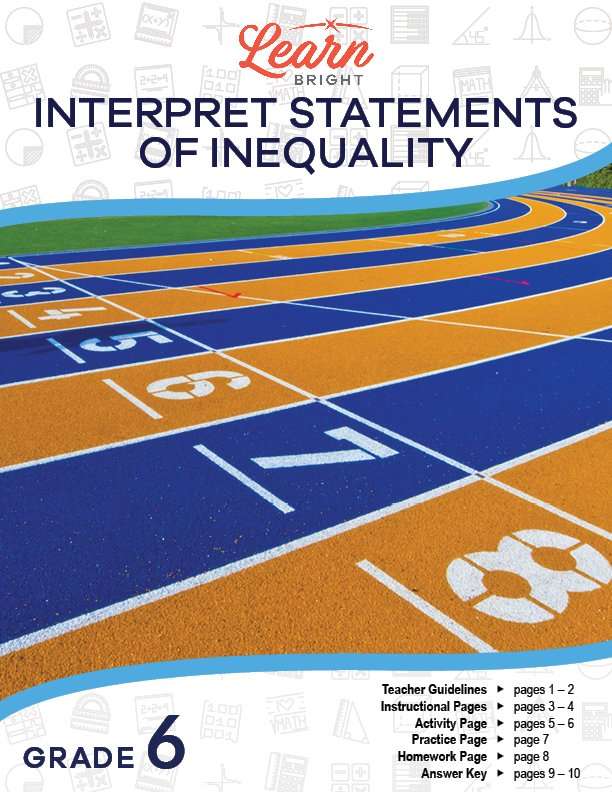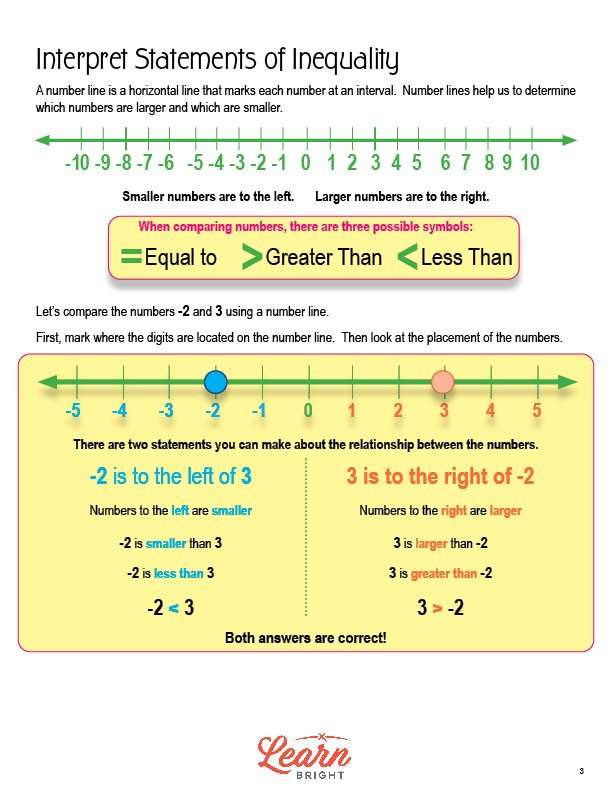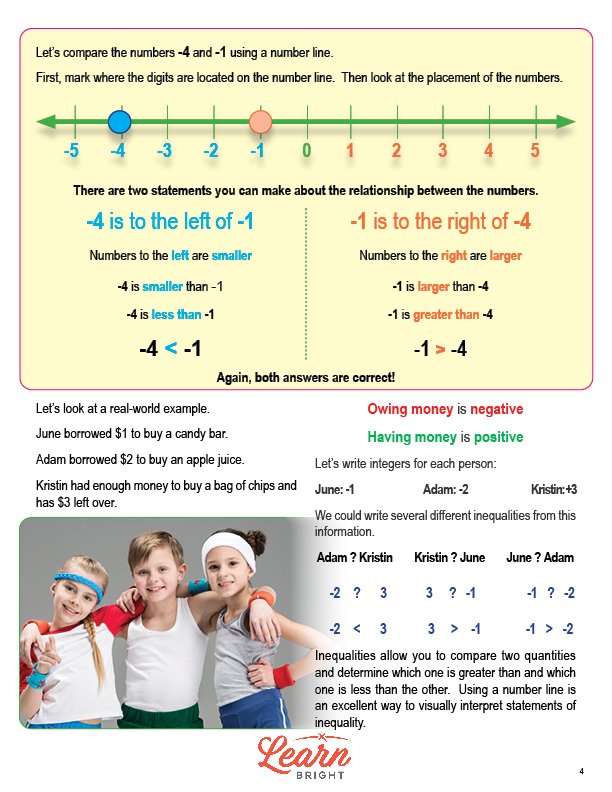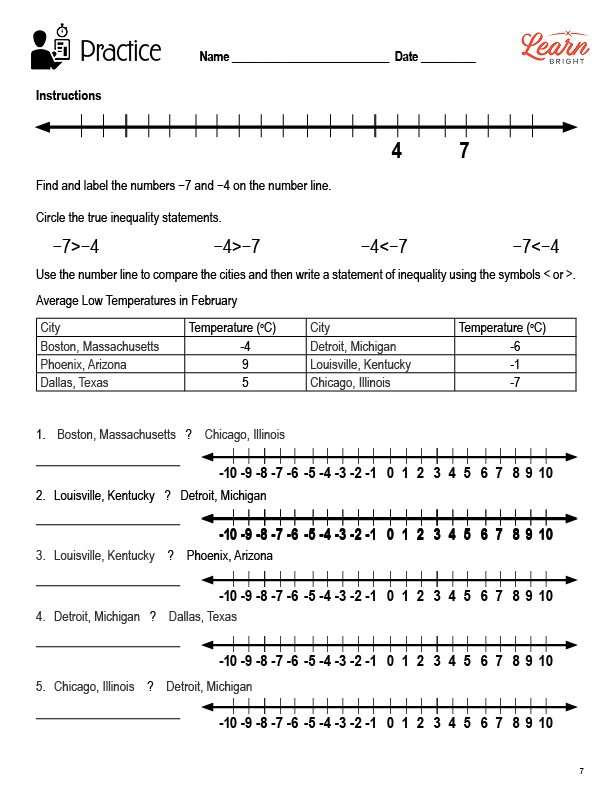Description
What our Interpret Statements of Inequality lesson plan includes
Lesson Objectives and Overview: Interpret Statements of Inequality teaches students how to interpret, write, and use statements of inequality. As well as, how to use the greater than, less than, and equal to signs. At the end of the lesson, students will be able to interpret statements of inequality about the position of two numbers on a number line diagram. This lesson is for students in 6th grade.
Classroom Procedure
Every lesson plan provides you with a classroom procedure page that outlines a step-by-step guide to follow. You do not have to follow the guide exactly. The guide helps you organize the lesson and details when to hand out worksheets. It also lists information in the blue box that you might find useful. You will find the lesson objectives, state standards, and number of class sessions the lesson should take to complete in this area. In addition, it describes the supplies you will need as well as what and how you need to prepare beforehand.
Options for Lesson
Included with this lesson is an “Options for Lesson” section that lists a number of suggestions for activities to add to the lesson or substitutions for the ones already in the lesson. One optional addition to this lesson is to have your students compare prices from local stores on a single product using information they gather from online such as the cost of a hamburger from several different chains. You could also have them compare the depth different sea creatures are able to live in. If you have more advanced students, they can begin to compare more than two numbers in compound inequalities.
Teacher Notes
The teacher notes page includes a paragraph with additional guidelines and things to think about as you begin to plan your lesson. This page also includes lines that you can use to add your own notes as you’re preparing for this lesson.
INTERPRET STATEMENTS OF INEQUALITY LESSON PLAN CONTENT PAGES
Interpret Statements of Inequality
The Interpret Statements of Inequality lesson plan includes two content pages. Number lines are horizontal lines that mark numbers at specific intervals. They help us figure out which numbers are larger and which are smaller. On a number line, smaller numbers are to the left and larger numbers are to the right. When we compare numbers, we use one of three symbols: = (equal to), > (greater than), or < (less than).
To compare the numbers -2 and 3 using a number line, we first mark where the digits are located on the number line and look at their placement. Looking at a number line marked with -2 and 3, we can make two different statements. First, -2 is to the left of 3. Because numbers to the left are smaller, we know that -2 is smaller than (less than) 3. Therefore, -2 < 3. Second, 3 is to the right of -2. Because numbers to the right are larger, we know that 3 is larger than (greater than) -2. Therefore, 3 > -2. Both -2 < 3 and 3 > -2 are correct answers!
The lesson includes another example, comparing -4 and -1. First, mark -4 and -1 on the number line. Looking at the number line, we can make two statements. First, -4 is to the left of -1. Because numbers to the left are smaller, we know that -4 is smaller than (less than) -1. Therefore, -4 < -1. Second, -1 is to the right of -4. Because numbers to the right are larger, we know that -1 is larger than (greater than) -4. Therefore, -1 > -4. Both -4 < -1 and -1 > -4 are correct!
The lesson also looks at a real-world example. Say June borrowed $1 to buy candy, Adam borrowed $2 to buy an apple juice, and Kristin has $3 left over after buying her snack. Who has more money than who? When you owe money, we write it as a negative. When you have money, we write it as a positive. Therefore, we can write the following integers for each person: June = -1, Adam = -2, and Kristin = 3. We can then use these integers to write different inequalities. Adam < Kristin, because -2 < 3. Kristin > June, because 3 > 1. And finally, June > Adam, because -1 > -2.
Using inequalities lets us compare two quantities and figure out which is larger and which is smaller. Using a number line is an easy and helpful way to visually interpret statements of inequality.
INTERPRET STATEMENTS OF INEQUALITY LESSON PLAN WORKSHEETS
The Interpret Statements of Inequality lesson plan includes three worksheets: an activity worksheet, a practice worksheet, and a homework assignment. You can refer to the guide on the classroom procedure page to determine when to hand out each worksheet.
CARDS ACTIVITY WORKSHEET
Students will work with a partner to complete the lesson activity. Each student draws a card from the deck. Red cards are negative numbers and black cards are positive numbers. Aces equal 1 and Jacks, Queens, and Kings equal 10. For each draw, students mark their number on their number line and write both verbal and algebraic inequalities.
INTERPRET STATEMENTS OF INEQUALITY PRACTICE WORKSHEET
The practice worksheet asks students to find and label the numbers -7 and -4 on the number line shown on the worksheet. They will then look at a list of inequality statements and circle each true statement. Next, they will use number lines to compare the average low temperatures in February in different cities and write statements of inequality using symbols (<, >, or =) for each.
CITY ELEVATION HOMEWORK ASSIGNMENT
For the homework assignment, students will use the chart of cities and their elevations to write inequalities using < or >. They will compare two cities at a time.
Worksheet Answer Keys
This lesson plan includes answer keys for the practice worksheet and the homework assignment. If you choose to administer the lesson pages to your students via PDF, you will need to save a new file that omits these pages. Otherwise, you can simply print out the applicable pages and keep these as reference for yourself when grading assignments.









